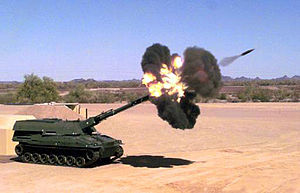XM2001 Crusader
| XM2001 Crusader | |
|---|---|

XM2001 Crusader firing a shell
|
|
| Specifications | |
| Weight | 43 tons |
| Length | 7.53 m |
| Width | 3.31 m |
| Height | 3.00 m |
| Crew | 3 (Commander, Driver, Gunner) |
|
|
|
|
Main
armament |
XM297E2 155mm cannon |
| Engine |
GE/Honeywell LV100-5 turbine engine 1500 hp (1119 kW) |
| Suspension | torsion bar |
| Speed | 39-48 km/h |
The XM2001 Crusader was to be the United States Army's next-generation self-propelled howitzer (SPH), designed to improve the survivability, lethality, mobility, and effectiveness of the artillery as well as the overall force. It was initially scheduled for fielding by 2008. United Defense was the prime contractor; General Dynamics the major subcontractor. In early May 2002, Secretary of Defense Donald Rumsfeld cancelled the $11 billion USD program because he considered it neither mobile nor precise enough. The prototype SPH vehicle is on display at the cannon park at Fort Sill.
The Crusader was intended to replace the M109A6 Paladin Self-Propelled Howitzer and the M992 Field Artillery Ammunition Support Vehicle (FAASV). It was intended to be an automated gun artillery system to support the Interim Brigade Combat Teams (IBCT) Counterattack Corps and a basis for other vehicle developments.
Key features of the Crusader design included:
Using the same chassis, the resupply vehicles (RSVs) would deliver automatic, reciprocal transfer of ammunition, data and fuel to the SPH or another RSV.
The Crusader program was cancelled, partly because it was considered too costly. The Pentagon preferred the Crusader design, largely due to its lighter weight. It also had a speed of around 40 mph (64 km/h) compared to the PzH 2000 speed of around 37 mph (60 km/h). However, the Pentagon refused German suggestions of producing a PzH that would have detachable armor, which could be shipped separately, or substituting titanium for steel in many parts.
Another consideration was that the existing Paladin already had advanced characteristics, making it still a very effective weapon.
Many of the technologies developed by the program were incorporated into the now cancelled XM1203 Non-Line-of-Sight Cannon.
...
Wikipedia
